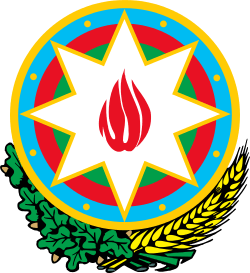Medicine in Azerbaijan
Medicine in Azerbaijan serves for protecting health and prosperity of citizens of the Republic of Azerbaijan. Reforms in the sphere of medical care and direction of health care system are parts of a global strategic development program of economic and social infrastructure. This program is based on principles of establishment of high life democratic society with market economy.[1]
Early history
History of medicine in Azerbaijan has deep roots. Ancient people believed in sorcery for struggle against various sicknesses. Carvings and painted signs in Azykh Cave dated from the Stone Age evidence about it.[2]
Early people used medicinal plants for treatment of different sicknesses. Their experience has developed and became a traditional medicine. Development of oral and written branches of traditional medicine was dividing with origination of writing.[3]

Rich flora of Azerbaijan attracted attention of doctors and scientists from ancient times. A lot of medicinal plants were used for prophylaxis and treatment. Seeds, roots, flowers and leaves of these plants were used in treatment. Women easily observed the influence fruits, vegetables and medicinal tea upon organism and their influence upon cough, bleeding, ache, diarrhea and other illnesses.[3]
From ancient manuscripts it is known that they used not only plants, but were also acquainted with surgery, treatment of tumors and setting of broken bones. For instance, Nariman Narimanov found a human skull dated from the 4th millennium BC (Eneolithic) with traces of trepanning on it, in Erefli village of Agdam Rayon.[2] In 1971, archeologist H.Kesemenli found out a skull dated from the late Bronze and early Iron Ages on which a trepanation was performed, in Khachbulag village of Dashkasan Rayon. R.Gasimova, who investigated the skull, said that “artificial trepanation was performed near junction of parietal and frontal bones”.[2]
In 1958, pitchers dated from the 6th century BC with burned rues which were used as medicine for treatment of rheumatism, fever and prophylactics of various illnesses, were found out in Garakepektepe village of Mugan plain during archeological excavations.[2]
Aromatherapy was also broadly spread. It was believed that smell of a quince strengthens body’s energy. Lemon was used for adjusting of nervous system, and apple for stimulation of brain’s work.
In ancient times there was an active cultural interchange between Azerbaijanis and residents of Mesopotamia. Sesame oil and crocus were imported from Sumer. There is information about medicinal drugs and medicine in Avesta, a sacred book of fire worshippers and the ancient monument of people of Azerbaijan and Iran.[5] There is also written that “a doctor has three weapons: word, herbs and a knife”. A doctor curing by words and suggestion was considered as the best at that time.[6]
Medicine of Caucasian Albania, descendants of which are considered Azerbaijanis, was also developing.[7] Medicinal plants were planted there from the Roman Empire. Works by Hippocrates and Claudius Galenus were popular there because of spreading of Christianity and Greek language. Some knowledge about medicine was taught in religious schools and churches.[8]
Development of medicine in the Middle Ages
In this period medicine was quickly developing which is evidenced by archeological findings. For instance, polished marble vessels for antimony and golden brushes for applying it, which was used as anti-cough and antiemetic medicine in the Middle Ages, were found out.[2] Sick men drunk wine from these made of antimony cups. Various glass vessels used for preparation and storage of medicines, which were used by alchemists both in traditional medicine and pharmacology, were found out in Shamakhi during excavations. These findings confirm that people in Azerbaijan were engaged in pharmaceutics in the Middle Ages.[2]
According to Farid Alakbarli, a historian Turkish traditional medicine which was called “Turkachare” and was similar to shamanism and treatment by wizardry and herbs began to be spread in the 4th century AD with entering of Turkic tribes into Azerbaijan. In Turkish doctors were called gam, which meant “shaman” or otachi which meant “herbalist”. Herbals were called ota (ot is herb in translation from Turkic). Goddess Oleng was considered as the patroness of doctors.[9]
In VIII Shirvan, where mainly Albanians and Iranians lived, was occupied by Arabs. Sciences and culture developed due to mutual influence of cultures as a part of single Caliphate. Universities, observatories, libraries, mosques and hospitals were built. Progress of medicine is observed namely in Islamic period. At that time, madrasa, where Arabic and Persian languages, religion, math, calligraphy, history and literature were taught, functioned in Azerbaijan. Medicine and alchemy were also taught there. “Malham” madrasa in Shamakhi was one of the most famous madrasa’s of that time. Eminent scientist and doctor Kafiyaddin Omar ibn Osman – uncle of eminent Azerbaijani poet Khagani Shirvani – led this educational institution.[9]
Copy of “The Canon of Medicine” work written in Arabic, in 1030, by doctor Ibn Sina, famed in Europe as “Avicenna” and who also was in Azerbaijan where he collected information about medicine, was found out in Azerbaijan among other manuscripts about medicine.[8] In his work Ibn Sina wrote about Saburkhast settlement in Azerbaijan.[8] This copy of “The Canon” was made in Baghdad, in 1143 and is considered one of the most ancient manuscripts in the sphere of pharmacology and medicine in the world and the most ancient in Azerbaijan, which was broadly used both in whole Muslim world and also in Christian Europe and which had a great influence upon development of medicine. There are descriptions of hundreds of medicines in it.[10]
- Copy of “The Canon of Medicine” work written in Arabic, in 1030, by doctor Ibn Sina, and made in 1143, in Baghdad. Institute of Manuscripts of Azerbaijan of Azerbaijan National Academy of Sciences, in Baku
-

-
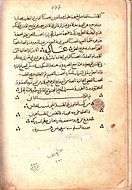
-
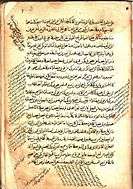
-

Bahmanyar al Azerbaijani (died in 1067), a student of Ibn Sina, also famed among scientists of the 11th century.[11] Bahmanyar touched upon issues in medicine in his philosophic work called “at-Tahsil” (“Understanding”).[8]
Manuscript copy of “Al-Magala as-Salasun” (“The thirteenth treatise”) written in the 13th century by Abu al-Gasim al-Zahravi, an eminent scientist from Andalusia, who famed in Europe as Abulgasis (died in 1013) also came from Azerbaijan. It is one of the most ancient manuscripts of this book. About 200 surgery instruments had been mentioned in this book. Their assignments also had been explained there. The work influenced upon development of surgery both in the East and also in Europe. Professor Ziya Bunyadov translated it into Russian and after it was published in Moscow, in 1983.[10]
- Manuscript copy of “Al-Magala as-Salasun” (“The thirteenth treatise”) written in the 13th century by Abu al-Gasim al-Zahravi, an eminent scientist of the 11th century. Institute of Manuscripts of Azerbaijan of Azerbaijan National Academy of Sciences, in Baku
-

-

-
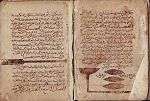
-

Medieval doctors warned sick people against tiredness. For example, Mahmud inb Ilyas, a doctor lived in the 12th century advised nervous people to listen to mugham.
Medicine was strongly developing in the 13th century in the Great Seljuq Empire of Azerbaijani Atabegs. Almost every eastern scientist and philosopher had a work in medicine. Residents from different oblasts of Azerbaijan compiled, rewrote and investigated books in medicine, including monuments of the 14th-18th centuries. There are more than four hundred manuscripts in medicine in Azerbaijani, Arabic, Persian and Turkish languages both written in the territory of modern Azerbaijan and brought from different oblasts in the Muhammad Fuzuli Institute of Manuscripts of Azerbaijan of Azerbaijan National Academy of Sciences, in Baku.[10][12] According to Kōichirō Matsuura, the former Director-General of UNESCO, “this collection shows the role of Azerbaijan in development of world medicine”.[13]
“Zahirai Nizamshahi” written by Rustam Jurjani in the 13th century was also partly investigated in Azerbaijan. Its manuscript had been copied in the 16th century is saved in Baku Institute of Manuscripts. There were descriptions of pharmaceutical herbs, substances of animal origin, minerals and some difficult medicines are included into it. The manuscript hasn’t been found in any other storage of the world and exists in only exemplar in Azerbaijan.[10]
- Copy of 16th century of “Zahirai Nizamshahi” written by Rustam Jurjani in the 13th century. Institute of Manuscripts of Azerbaijan of Azerbaijan National Academy of Sciences, in Baku
-
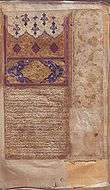
-
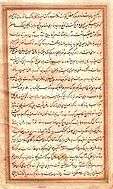
-
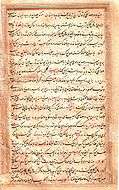
-

“About treatment science” work by Mahmud ibn Ilyas (the 14th century) in which fundamental ideas of medicine, symptoms and reasons of specific illnesses are described also famed.

Yusif Garabaghi, an Azerbaijani doctor of the 16th century, who came from Karabakh, wrote many medicine treatises and also “Explanations and interpretations of “The Canon of Medicine” by Ibn Sina”. He lived in Central Asia for a long time and taught in Samarkand.[5]
Mir Muhammad Momin, palatial figure at Suleyman the Safavid, wrote several instructive works in Persian, including “Tohfat al Mominin” in 1669. Descriptions of more than 4000 plants, animals, minerals and other ingredients used in medicine were written in the work. Momin described each plant, its specific characteristic, where it can be picked, other oblasts where it is used and its name in other languages such as Chinese and Hindi in detail.
In 1712, Muhammad Yusif Shirvani wrote “Tibbname” in Azerbaijani language. Being a palatial doctor, Shirvani advised to use natural minerals for treatment, for example, rubbing of orange peel while tiredness in neck. In this work it’s also written that resting place of sick men should be decorated with flowers in light-blue, green and white tints. It means that even the color had a great importance in works of medieval healers.
Generally, in the 17th-18th centuries, number of works had been written in the sphere of medicine and pharmacology by Azerbaijani scientists such as Murtuzagulu Shamlu (sexual pathologist), Abdulhasan Maraghai, pharmacologists such as Hasan Rza oglu Shirvani, Haji Suleyman Iravani and others. 724 kinds of medicinal plants were described.[9]
Development of medicine in the 19th and early 20th century
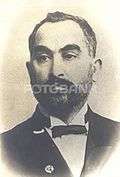
In the early 19th century when northern khanates of Azerbaijan (Shirvan, Baku, Nakhchivan, Quba, Talysh, Karabakh, Shaki, Derbend and other) were joined to Russia and the southern (Tabriz, Khoy, Ardabil and others) ones to Iran, Azerbaijani community in Iran continued to exist under the influence of Persian and generally, the whole Islamic culture, but Azerbaijani community in the Russian Empire (later the USSR) was developing under the influence of Europeanized secular Russian culture (mainly in the Soviet times). Medicine in two regions was developing in two different ways.[9]
There wasn’t any European like pharmacy in Azerbaijan until 1828. During the reign of the Russian such hospitals and pharmacies were established in Azerbaijan as in the whole South Caucasus, where Russian doctors applied their skills.[3]
Abdulkhalig Akhundov founded basis of scientific investigation in the history of medicine in Azerbaijan. Abdulkhalig studied and translated famous pharmaceutics encyclopedia written by Abu Mansur Kharavi in the 9th century from Persian into German. After, the book was published in Germany. Abdulkhalig Akhundov also defended a dissertation in the history of medicine at the University of Tartu.[9] In 1895, Dr.Mammad Rza Vakilov, Dr.Kerimbey Mehmandarov and others established Baku Union of Medicine.[9]
Hasan bey Zardabi and Mirza Fatali Akhundov used knowledge in medicine in their works for expression of philosophical ideas.[3] Akhundov was one of the firsts who acted against traditional healers. He was the author of works about hygiene and sanitary. Zardabi also had an important role in development of medicine. He was the first Azerbaijani in the sphere of natural history and Social Darwinism.
Being the author of “Akinchi” – the first Azerbaijani newspaper in the Russian Empire – Zardabi, together with Akhundov worked upon works about malaria devastated the country at that time. His “Hygiene” book is the first scientific research work about medicine in the sphere of hygiene in Azerbaijan. It was published in 1914, in Azerbaijan.
Sometimes doctors gave gratuitous help to sick men. During cholera devastation in Nakhchivan, in 1847, Mirza Nasrulla Mirza Ali oglu gratuitously treated both Azerbaijani and Armenian sick men, due to which he was respected among people.[5]

Alongside all these, pharmacies where herbs imported from Iran and India were sold, were also functioning at that time. Such pharmacies were in every city of Azerbaijan – Baku, Shamakhi, Shusha, Agdam, Nakhchivan, Lahij, Ordubad, Salyan, Lankaran etc. Mir-Baba Mir-Abdulla oglu, father of eminent Azerbaijani literary man Yusif Vazir Chamanzaminli had a pharmacy in Aghdam. 142 kinds of medicines, more than 100 of which were made of herbs, were sold in his pharmacy. Chamanzaminli himself, being the son of the pharmacist, described everyday life and practices of Azerbaijani healers of the 19th century in his narrative called “The Doctor”.[5]
Such pharmacies were mainly in Iranian (Southern) Azerbaijan.[3] At the beginning of the 20th century treatment by herbs was enough spread method of treatment in Azerbaijan. But healers perceived appearance of new, modern medicines as something strange.
“Molla Nasraddin” – popular Azerbaijani magazine of that time, which was of great importance in medicine education, criticized such kinds of remains of the past, ridiculed backwardness of healers-evils of that time, their ignorant treatment of modern knowledge in medicine.[3] For instance, a caricature called “Holy Bukhara” (painted by Azim Azimzade) was given in the 20th issue of the magazine (1911).[14] Here the image of Bukhara emir, doubtfully treating recommendations of the doctor about a new medicine.
Medicine in Azerbaijan Democratic Republic
In 1918, Ministry of health-care led by Dr.Rafiyev was established in independent Azerbaijan Democratic Republic. Dozens of new pharmacies and hospitals were opened in Baku and Ganja at that time.
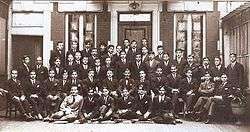
Many students of Azerbaijan Democratic Republic sent for educating abroad, mainly to Germany, Saint Petersburg, Moscow, Kiev and other cities, learned medicine there.[3]
In 1919, Baku State University with a medicine faculty was established in Baku. Professor V.I.Razumovskiy, an eminent surgeon, became its first chairman (until 1920). History of medicine was also taught there. Razumovskiy established the First Preparatory Commission for a short period of time. Admission examinations were held in August of the same year and so the first course of students – future doctors – was collected.[15]
On August 2, 1922 there were only three Azerbaijanis – A.Alakbarov, Jeyran Sultanova and Adliya Shahtakhtinskaya-Babayeva, who became the Doctor of Sciences and Professor – among the first 29 alumni of medicine faculty.[3]
Medicine in the Azerbaijan SSR
After establishment of the Soviet Power, during the 1920s, pharmacies where herbs were sold were closed, and manuscripts written with Arabic alphabet were burned. It was a part of the Soviet Power’s policy carried out against Islam (mainly in Azerbaijan and Central Asia).[3]

Nariman Narimanov, who also was a doctor, was the leader of a newly established administration. From 1920 to 1921 Aghahuseyn Kazimov and then in 1935 Mir Movsum Gadirly were national commissars of health-care in the Azerbaijan SSR.[9]
In 1930, Azerbaijan State Medical Institute was established and M.N.Gadirly was its first rector. Eminent scientists and professors such as I.Shirokorogov, S.Davidenkov, F.Ilyin, Lev Levin, N.Ushinkiy, k.Malinovskiy and others had a great contribution on development of the institute. Scientists such as M.Mirgasimov, M.A.Topchubashov, A.M.Aliyev, I.M.Ismayilzade and others graduated from this institute, who then brought Azerbaijani medical science fame.[15]
Generally, from 1920 to 1940 hundreds of polyclinics, hospitals and pharmacies were established in Azerbaijan. Academicians such as Mirasadulla Mirgasimov and Mustafa Topchubashov, and professors such as Alibey Alibeyov, Kamil Balakishiyev and others were world-famous scientists and doctors of Azerbaijan.[9]
Medicine in the Republic of Azerbaijan
New stage in development of medicine began after Azerbaijan acquired independence.[1] More than 10 laws were established in the sphere of health-care. In March 1998, Heydar Aliyev, former president of Azerbaijan, signed a direction “About establishment of State Committee of reforms in the sphere of health-care”. Unique state policy was established in the country and quality of medical service of the population was also improved. Today medical centers and modern pharmaceutics industry of Azerbaijan is created at a level of world standards. A national plan against illnesses such as HIV/AIDS and tuberculosis is developed in the country. In 2001, a direction about celebration of June 17 as a holiday of health-care employers was signed. In 2004, Azerbaijani Association of Medicine Historians which was included into International Union of the History of Medicine headquartered in Paris, in 2005, was established. The First National Conference of the Association was held on February 1–2 of the same year in Baku.[9]
Since February 1, 2008 governmental medical institutions show a gratuitous medical aid to population, by a direction signed by Ogtay Shirinov, a minister of health-hare of Azerbaijan. In November, 2009, Azerbaijani doctors performed the first operation in heart for prevention of arrhythmia.[16]
43 new hospitals and diagnostic centers, 46 outpatient polyclinics, 4 restoration centers for disabled persons and 12 diagnostics and health centers were put into operation during the last years. 30 medical institutions and 5 polyclinics are to be constructed in 2013.[1] Indicators of longevity and birth rate have improved because of the development of the medicine in the country.
References
- 1 2 3 Искендер Гулиев, директор центра мониторинга "Право выбора". (2 February 2010). "Система здравоохранения Азербайджана подводится под уровень мировых стандартов.". azeri.ru. Archived from the original on 2012-04-16.
- 1 2 3 4 5 6 Ахмедова Вафа Шамиль гызы, диссертант Азербайджанского государственного университета строительства и архитектуры. (16 February 2009). "Археологические материалы в азербайджанской народной медицине.". jurnal.org. Archived from the original on 2012-04-16.
- 1 2 3 4 5 6 7 8 9 Dr. Nigar Efendiyeva, medical historian at the Academy of Sciences. (Winter 1995). "Medicine in Azerbaijan. A Brief Historical Overview.". azer.com. Archived from the original on 2012-04-16.
- ↑ "Шиповник собачий.". GRIN. Archived from the original on 2012-04-16.
- 1 2 3 4 Фарид Алекперли, доктор исторических наук. (2006). "История медицины в Азербайджане.". Веб-страница Фарида Алекперли. Archived from the original on 2012-04-16.
- ↑ Авеста. Священная книга зороастрийского учения. Tehran. 1967. p. 47.
- ↑ З. И. Ямпольский. "Албания Кавказская.".
- 1 2 3 4 Фарид Алекперли, доктор исторических наук. (2006). 1001 секрет Востока. Baku. p. 4. (Azerbaijani)
- 1 2 3 4 5 6 7 8 9 Фарид Алекперли, доктор исторических наук. (2006). "Хронология азербайджанской медицины.". alakbarli.aamh.az (Веб-страница Фарида Алекперли). Archived from the original on 2012-04-16.
- 1 2 3 4 Бюро ЮНЕСКО в Москве (2006). "Средневековые рукописи по медицине и аптечному делу.". unesco.org. Archived from the original on 2012-04-16.
- ↑ Nicholas Rescher, «The development of Arabic logic», University of Pittsburgh Press, 1964. p. 157:
«Abu 'l-Hasan Bahmanyar ibn al-Marzuban was a Persian, a younger contemporary and respected student of Avicenna»
- ↑ Медицинские рукописи средневекового Азербайджана
- ↑ Communication and Information Sector's news service. (13-06-2006 (Paris/Baku)). "Conference on traditional medicine and pharmacy in medieval manuscripts in Baku opened". UNESCO. Archived from the original on 2012-04-16. Check date values in:
|date=(help) - ↑ "Молла Насреддин" (1911 г., № 20). "Священная Бухара.". Zerrspiegel. Archived from the original on 2012-04-16.
- 1 2 "История Азербайджанского медицинского университета.". Официальный сайт Азербайджанского медицинского университета. 16 October 2009. Archived from the original on January 9, 2012. (Azerbaijani)
- ↑ Kəmalə Məmmədova (2009). "Azərbaycanda ilk dəfə ürək aritmiyası əməliyyatı aparılıb". ANS TV. Archived from the original on 2012-04-16. (Azerbaijani)
External links
- Medicine in Azerbaijan. A Brief Historical Overview. By Dr. Nigar Efendiyeva
- The Medical Manuscripts of Azerbaijan. By Betty Blair
- Средневековые рукописи по медицине и аптечному делу
- Medieval manuscripts on medicine and pharmacy

